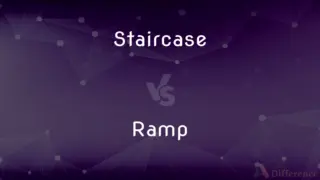Anime vs. Chibi — What's the Difference?
Edited by Tayyaba Rehman — By Maham Liaqat — Updated on May 8, 2024
Anime refers to Japanese animated works across various genres and styles, often featuring complex plots and characters, while chibi describes a specific drawing style used in anime and manga, characterized by exaggeratedly small and cute characters.

Difference Between Anime and Chibi
Table of Contents
ADVERTISEMENT
Key Differences
Anime encompasses a broad category of Japanese animation that includes a wide range of art styles, storylines, and themes. Series like "Naruto" and "Attack on Titan" represent different genres but are both considered anime. Chibi, on the other hand, refers to a specific stylistic approach in drawing characters. These characters have oversized heads, small bodies, and are often drawn to appear adorable and playful.
Anime can vary significantly in art style, tone, and target audience. It includes anything from action-packed adventures to romantic dramas or slice-of-life stories. Meanwhile, chibi is more about visual exaggeration and is often used to depict characters humorously or endearingly.
In anime, chibi-style drawings might be employed to convey lightheartedness or comic relief in otherwise serious scenes. An entire series can use the chibi style, but it's more often seen as a comedic or artistic deviation from the main animation.
While anime represents the entire medium of Japanese animation, chibi is a specific artistic choice used within anime or manga.
Comparison Chart
Definition
Japanese animated works
Drawing style with exaggerated small characters
ADVERTISEMENT
Art Style
Varies widely, from realistic to stylized
Overemphasized head, tiny body
Scope
Encompasses all animation genres
Limited to specific visual style
Usage Context
Entire medium
Often used within anime/manga as a stylistic choice
Example
"My Hero Academia," "One Piece"
Chibi versions of popular anime characters
Compare with Definitions
Anime
Japanese animated works.
She enjoys watching anime like 'Fullmetal Alchemist.'
Chibi
Exaggerated, cartoonish version.
The artist drew chibi versions of the main characters.
Anime
Includes diverse genres.
From romance to sci-fi, anime covers a broad range of themes.
Chibi
Used for comic relief.
Chibi scenes often add humor to anime episodes.
Anime
Significant cultural phenomenon.
Anime conventions attract fans of all ages.
Chibi
Sometimes used as merchandise.
Chibi keychains and figures are popular among anime fans.
Anime
Animation style originating in Japan.
Anime often differs from Western cartoons in storytelling.
Chibi
Art style with small, cute characters.
Chibi drawings feature big heads and tiny bodies.
Anime
Visual storytelling medium.
Many anime adapt popular manga series into animated form.
Chibi
Adorable and simplified design.
Chibi style simplifies complex character designs.
Anime
Anime (Japanese: アニメ, IPA: [aɲime] (listen)) is hand-drawn and computer animation originating from Japan. In Japan and in Japanese, anime (a term derived from the English word animation) describes all animated works, regardless of style or origin.
Chibi
A child-like character with exaggerated features, particularly in anime.
Anime
A style of Japanese film and television animation, typically aimed at adults as well as children.
Chibi
A style of cartooning in which the characters are drawn to be very small and cute.
Anime
A style of animation developed in Japan, characterized by stylized colorful art and often adult themes.
Anime
(uncountable) An artistic style originating in, and associated with, Japanese animation, and that has also been adopted by a comparatively low number of animated works from other countries.
I can draw an anime version of you, if you want.
Anime
(countable) An animated work that originated in Japan, regardless of the artistic style.
Anime
An animated work, regardless of the country of origin.
Anime
Alternative spelling of animé, the resin of the courbaril.
Anime
Of a different tincture from the animal itself; - said of the eyes of a rapacious animal.
Anime
A resin exuding from a tropical American tree (Hymenæa courbaril), and much used by varnish makers.
Anime
A hard copal derived from an African tree
Anime
Any of various resins or oleoresins
Common Curiosities
Is chibi a type of anime?
No, chibi is a style within anime but not a separate genre itself.
Can an entire anime series be chibi-style?
Yes, some series use the chibi style throughout or as spin-offs.
Why are chibi characters used in anime?
They are often used for comic relief or to add a playful, lighthearted element.
Are chibi characters ever used for dramatic scenes?
Not typically; chibi characters are generally used in humorous or informal contexts.
What does anime mean?
Anime refers to Japanese animated works across genres, styles, and themes.
Are chibi characters used in video games?
Yes, chibi characters often appear in games as well.
What is chibi in relation to anime?
Chibi is a specific drawing style used in anime, featuring small, cute characters with exaggerated features.
Is anime limited to a specific age group?
No, anime has content suitable for children and adults alike.
Can Western cartoons use the chibi style?
Yes, any artist can use the chibi style, regardless of cultural background.
What genres does anime include?
Anime includes action, fantasy, romance, sci-fi, horror, slice-of-life, and more.
Are chibi characters only found in anime?
No, they can also appear in manga, art, or merchandise.
Are all anime characters drawn realistically?
No, art styles in anime range from realistic to highly stylized.
Is anime considered a significant cultural export?
Yes, anime is widely recognized and influential worldwide.
What makes chibi characters recognizable?
Their distinctive large heads, small bodies, and simplified features make them instantly recognizable.
How did the chibi style originate?
The style developed within Japanese manga and anime culture to depict characters humorously.
Share Your Discovery

Previous Comparison
Plenum vs. Vacuum
Next Comparison
Staircase vs. RampAuthor Spotlight
Written by
Maham LiaqatEdited by
Tayyaba RehmanTayyaba Rehman is a distinguished writer, currently serving as a primary contributor to askdifference.com. As a researcher in semantics and etymology, Tayyaba's passion for the complexity of languages and their distinctions has found a perfect home on the platform. Tayyaba delves into the intricacies of language, distinguishing between commonly confused words and phrases, thereby providing clarity for readers worldwide.














































